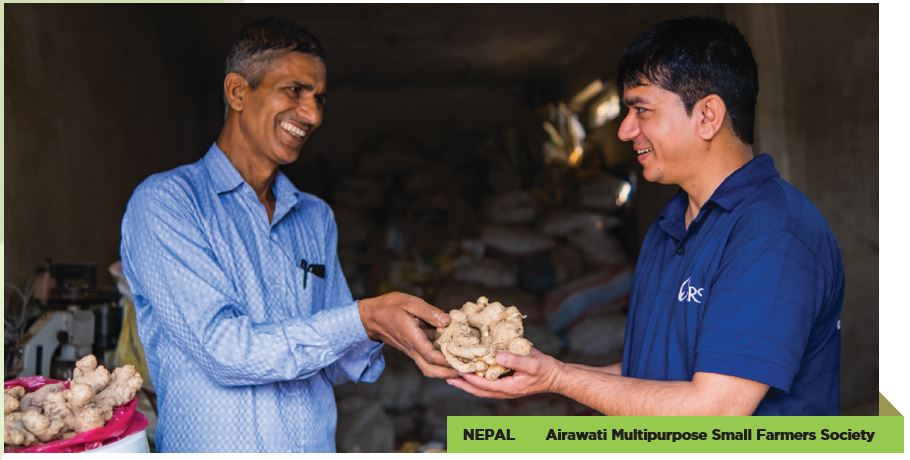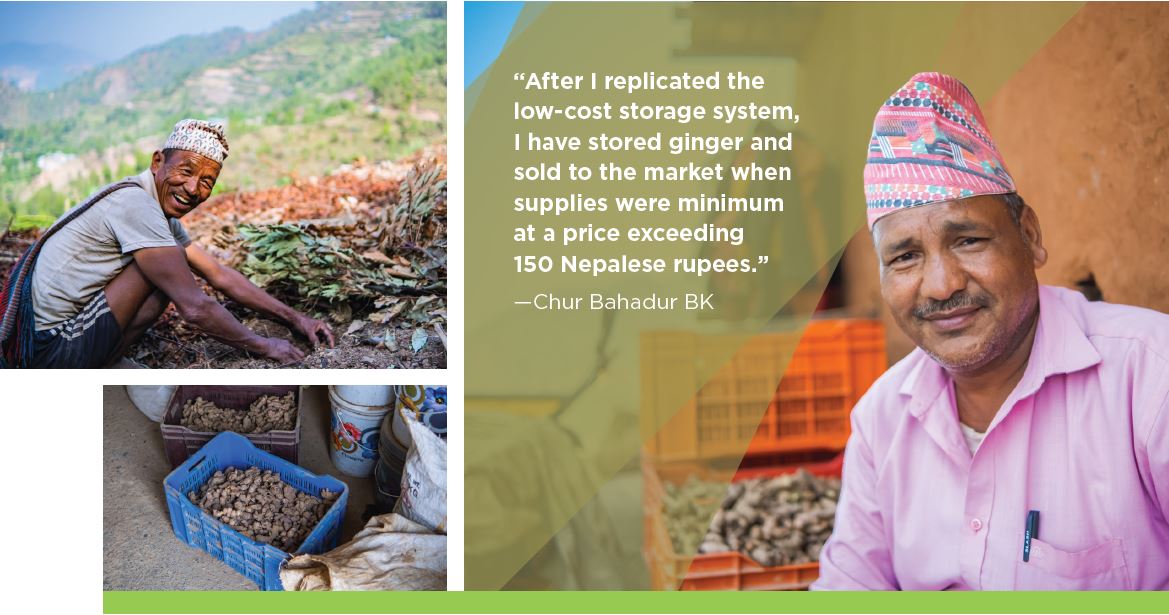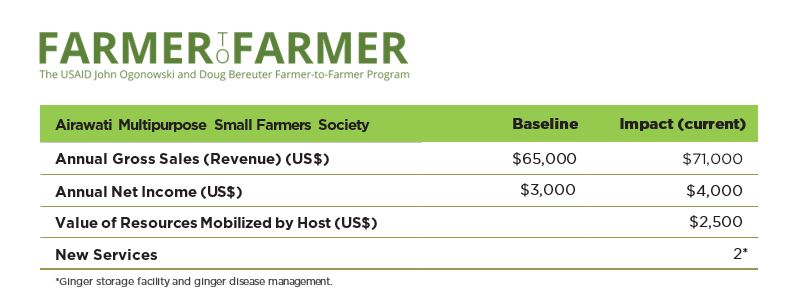

Nepal is the third largest producer of ginger in the world. Despite that, smallholder farmers have struggled to see profits from their crop.
Rhizome rot, pests, inefficient water use, challenges with farm management and limited access to farm extension services all hamper a productive ginger harvest.
In addition, farmers also face a classic problem: At harvest, when ginger is plentiful, prices paid to farmers drop. But holding their ginger means risking losing stock to disease and dehydration. So traditionally, smallholders are forced to sell ginger even when the prices are low.
Catholic Relief Services in Nepal, in collaboration with Agriculture and Forestry University, conducted an inclusive value chain study to understand and address the specific barriers that smallholder farmers face. The study results highlighted the importance of developing low-cost storage solutions that could help farmers in ginger disease management as well as provide long or short-term storage of ginger until market prices are favorable.
To introduce smallholder farmers to low-cost storage solutions, CRS Nepal tapped the U.S. Agency for International Development’s Farmer- to-Farmer, or F2F, program for assistance.Through F2F, U.S. volunteer Ahmad Reza Rafie, a professor from Virginia, was invited to conduct training at Airawati Multipurpose Small Farmers, a cooperative in Pyuthan district of Nepal.
Established in 2001, Airawati Multipurpose Small Farmers consists of 1,221 members of which 60% are women farmers. The cooperative is well known in the municipality for actively engaging in the production and supply of local agricultural products such as ginger, turmeric, honey and beans.
During the training, Professor Rafie shared information on rhizome rot management and the importance of proper storage. A local F2F volunteer and a retired agricultural scientist from Nepal, Govind KC, demonstrated how to build low-cost ginger storage using easily available local resources as well as technologies that improve crop survival and increase income and livelihoods opportunities. Farmers also learned ginger planting techniques that prevent disease and lead to more robust production.
Working with F2F volunteers, Airawati Multipurpose Small Farmers built a low-cost ginger storage unit at their headquarters. It cost a total of 15,000 Nepalese rupees ($120) to construct the unit, which was made from raw bricks and soil. Once the structure is stable, farmers store ginger in a 4-inch layer of fine sand covering a 10-inch layer of ginger. The results of storing the ginger in the newly constructed storage were striking.
After storage, the ginger was fresh and had retained its weight compared to the old storage method which made the ginger lose some weight due to drying. The practice also offered fresh ginger seeds for the next planting season.

“Before I came to know about the storage system technique, I had no option but to sell my ginger to the market at an exceptionally low price of 20 Nepalese rupees (15 cents) per kilogram which barely met my labour cost,” says Chur Bahadur BK, a local ginger farmer from Pyuthan. “But after I replicated the low-cost storage system, I have stored ginger and sold to the market when supplies were minimum at a price exceeding 150 Nepalese rupees ($1.14).”
Chur adds that he plans to build more storage for his harvest of more than 20 tons of ginger every year and plans to maximize his profit in times like May and June when ginger fetches as much as 220 Nepalese rupees ($1.68) per kilogram. That is a significant increase in earnings from 20 Nepalese rupees.
Like Chur, there are many other farmers who are extremely excited to learn about this cost-
effective storage methodology and are all planning to build a facility for themselves.
Following Airawati’s advocacy, the local government will cover half of the cost of building the storage facilities, making them even more accessible to smallholder farmers.
Airawati Multipurpose Small Farmers credit the F2F team in Nepal and Ahmad Reza Rafie for making these beneficial changes possible.
Complementing the Farmer-to-Farmer work, CRS Nepal, with funding from USAID, will be implementing a Feed the Future Food Systems for Nutrition Innovation Lab research proposal titled, “Actions to Support Storage, Packaging, and/or Cooling Innovations for Perishable Foods in Target Geographies.” In partnership with Purdue University, the 3-year project will support smallholders to develop and adopt locally appropriate storage solutions.
Click here to download this story as a PDF

The CRS F2F program is a USAID-funded program focused on reducing hunger, malnutrition, and poverty across six countries: Benin, Timor-Leste, Ethiopia, Nepal, Rwanda, and Uganda. The program runs from 2018-2023 and aims to generate sustainable and broad-based economic growth in the agricultural sector. U.S. volunteers with agricultural expertise share skills and help build capacity for farmers through short-term training and technical assistance projects resulting in more productive, profitable, sustainable, and equitable agricultural systems.
Photos by Amit Rudro for CRS